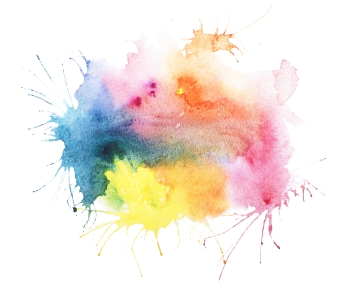
Deep breathing is a great tool to relax the body and mind by oxygenating the blood, slowing the heart rate and allowing the brain to function more effectively. Guided meditation and visualization allow the imagination to be used in productive ways, as opposed to unproductive imaginings, such as when you get caught up in thinking of worst case scenarios. This tip, Color Breathing Guided Meditation, will show you how to combine the relaxing effects of both as it walks you through using visualization to pair an emotion with a color then adding deep breathing to reduce an unwanted emotion and enhance an emotion you’d like to feel.
Step 1 of The Color Breathing Guided Meditation: Identify Emotions and Colors
For this exercise, identify a current emotion you feel that you want to reduce. Now imagine that each emotion can be visually represented by a color. Ask yourself, what color does my anger feel like? What color is my fear? My anxiety? The color you sense is subjective, so it doesn’t matter what color you visualize as long as it makes sense to you.
Now imagine the opposite emotion, or the emotion you’d like to feel. Tune in to that emotion and see what color it is. Now you’ve established what emotion you want to reduce and what emotion you want to grow and what colors you associate with each emotion at this moment.
During this exercise, you will be breathing in the emotion you want to feel and breathing out the emotion you don’t want to be feeling by imagining inhaling and exhaling the colors associated with those emotions.
Step 2 of The Color Breathing Guided Meditation: Body Scan- What does your emotion feel and look like?
For the ease of this exercise, pick one emotion you’d like to reduce. I’m going to use anxiety as an example, since it’s a very common feeling I encounter in my therapy practice and out in the world, yet you can pick any emotion you’d like when you try this on your own.
Now close your eyes and turn your focus inwards. Scan your body from head to toe and notice where you feel anxiety in your body. You might notice it in the form of pain, tension, or uneasiness, for example. How much of your body does the anxiety cover?
If you had to give anxiety a color, what color would you give it? How bright is it right now? I often hear anxiety described as an orangy-red color, so this is what we will use for this exercise, but remember, the color of your emotion is subjective and up to you. The color you choose here is the color you are going to exhale in the breathing portion of the exercise.
You might start to feel like your anxiety is more than one color. Perhaps different colors represent different ways that anxiety is expressed in the body (upset stomach versus shoulder tension), or in the mind (old lingering worries versus recent acute fears). The more you can visualize your anxiety the better, but let’s start by taking just one color at a time. You can choose to focus on one part of your anxiety that is represented by one color, or choose to picture your anxiety as a whole as one overall color. Picking one color will make this exercise much easier to complete. But again, once you get the basics down, you can get creative and make this work for you in whichever way you like.
Now, what emotion do you want to feel? You could think of the opposite emotion, or just one that feels more positive or productive. If we’re going with anxiety as an example, many people identify wanting to feel peacefulness instead and often picture it to be a blue or green. What color is peacefulness to you? Pick a color that represents this ideal emotion and that is the color you are going to breath in.
Step 3 of The Color Breathing Guided Meditation: Deep Breathing
For now we are practicing by inhaling blue (peacefulness) and exhaling orange (anxiety). Now imagine as you inhale to the count of 4, that you are bringing in blue light from the air around you, from the earth, the heavens, the cosmos- anywhere and everywhere you can draw it from. As you inhale, pull that peaceful blue light up through your nostrils and into the top of your head, all the way down to your toes and out your feet. Feel the air drawn down through every inch of your body. When you exhale to a slower count of 4, imagine anxiety as orange light being pulled from the deepest parts of every cell affected by it up and out through your nostrils. Continue breathing in and out until the positive emotion replaces the negative emotion, when you can feel and picture the color blue overtaking the color orange.
Being able to picture the colors can help you get a sense of how well you’re shifting the emotions in your body and mind. It may take a few minutes to replace the negative emotion with the positive one. The timing depends on how much anxiety there was in your body to begin with and how intently you imagine the colors flowing in and out of you.
Step 4 of The Color Breathing Guided Meditation: Second Body Scan - How well are you doing?
As you go, you should be visualizing the colors shifting in your body. Notice what you are feeling from head to toe as you breath. You can even pause from the breathing and rescan your body at any point to notice progress and challenges. What areas of the body are most difficult to infuse with peacefulness? How bright is the orange now? You can laser focus onto the parts of you where the anxiety feels stuck and send the blue light directly to that spot for as long as you need. Say you just can’t let go of that shoulder tension. Just imagine that blue light coming in through your nostrils, traveling to your shoulders and illuminating each muscle fiber with a calming blue light. Then picture that sticky, heavy orange color lifting from your muscles and flowing out your nostrils as you exhale.
Step 5 of The Color Breathing Guided Meditation: Modification
To do this exercise thoroughly, it is recommended to try to replace all the negative emotion’s color with the positive. For example, replace all the orange in your body with blue. See how you feel after trying this exercise for a good 5-10 minutes. If you can do it in less time, that’s great! Your imagination is powerful and effective, for better or for worse. You might need longer to shift your emotions, and that’s ok too! These things can take practice.
Once you finish doing this exercise one time completely, you will have a sense of what it feels like, what’s involved, and what works best for you. Now it will be easier to modify for when you’re on the go or just unable to spend a good chunk of time meditating. You can do a version of this exercise in just one breath! Identify the color you want to inhale and exhale, and give yourself one or two really thorough breaths of those colors in and out. It’s like when you’re overwhelmed and naturally sigh. Now just add colors to that sigh and you’ve made it that much more intentional and effective.
If you want to take it a step further, you could give yourself a reminder of how you want to feel by wearing the color you identified with that feeling or adding that color to your home. A blue shirt, piece of jewelry, or throw pillow could be a fun way to remember to chill out when you start feeling anxious. Again, this is all about using the imagination in intentional, productive, healthy ways, so get creative!
Remember, you can use this Color Breathing Guided Meditation as a tool to shift your emotions to help you feel better. It can last as long or as short as you want or need it to. You have the power to impact how you feel, and this is just one tool to add to your toolbox. If you’d like additional support in managing emotions, please call The Center For Growth.
f you need help determining which therapist might be a good fit for you, or you want morning hours (6am-12 noon), very late evening hours(8-10pm), or specific weekend times, group therapy or you have an unusual situation call (215) 922-LOVE and speak to the intake coordinator or call the founder of the organization Alex Robboy (267) 324-9564 to discuss your particular situation. Most of our therapists offer more hours than what is posted online, some appointment time slots can only be scheduled by calling us. We have a wide range of therapists at The Center for Growth / Therapy in Philadelphia.
There are 17 therapists at the Center for Growth. We each have our own unique area of expertise. Between the 17 of us, we pretty much cover every topic. Not all of us do everything. Additionally, our own backgrounds shape how we see the world. We have Black therapists, Asian therapists, Caucasian therapists, Male therapists, Female Therapists, GLBT therapists, Jewish therapist, Christian therapists, and Muslim therapists, married therapists, single therapists, mom therapists, doctoral and masters level therapists, old therapists and young therapists. To find the right therapists for you, please feel free to read the therapists biographies or call and speak with one of us today.






















